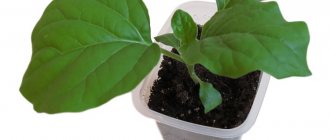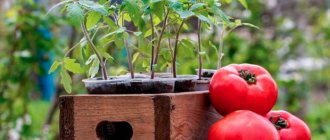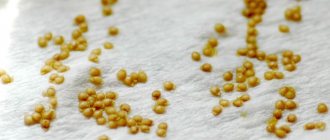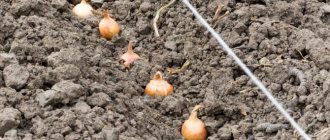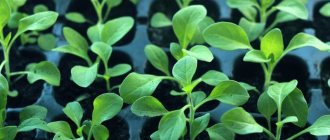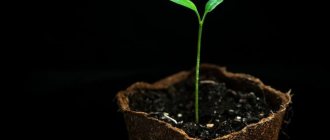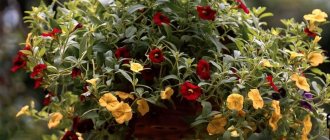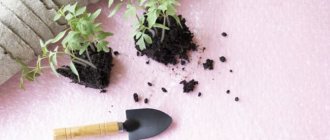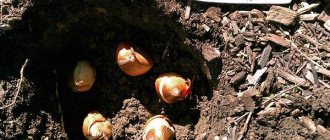In order to grow heat-loving bell peppers in our latitudes, we need strong, healthy and hardened seedlings. And getting them is not so easy. He is capricious and demanding. Belongs to the genus Capsicum, in its natural environment it lives only in the American tropics.
Capsicum needs good lighting and does not tolerate hypothermia and drafts. Loves light, nutritious, fertile soil, with low or neutral acidity. Requires compliance with crop rotation rules.
Each gardener develops his own experience. It contains knowledge not only of how and when to plant seeds in the ground, but also how to care for seedlings.
But favorable and unfavorable days are also taken into account. They are determined according to the Lunar calendar. Also read when to plant tomatoes this year.
When to plant
On the eve of the start of spring work, the question of planting pepper seedlings always arises. Experienced gardeners navigate based on the climatic conditions of their residence. As a rule, young growth of early varieties is transferred to the ground at the age of 50-60 days, when the last spring frosts have passed.
- Capsicum varieties of medium ripeness are planted in the ground at the age of 60 days.
- And late ripening - at the age of 65-75 days.
Here, in the southern regions of Eastern Siberia, young shoots are transferred to the ground after June 10, and to the greenhouse in May. Rewinding 65 days from these numbers, you can determine the number of plantings of different varieties in the ground for its cultivation. We plant peppers in the greenhouse in the second half of May. Therefore, the first shoots appear on the windowsill in March.
Planting seeds for seedlings by region
The time when sowing begins depends on the region where it is planned to grow this vegetable. But he loves warmth very much, and early transplanting to the garden bed can easily destroy him.
Table 1.1 - Planting by region
| Region of Russia | Features and sowing time |
| Northern Caucasus, Krasnodar region, Crimea | From January 25-31 From 1-5 February Transplantation of seedlings begins after April 20. |
| Siberia | Early ripening varieties are recommended for sowing. Dates: from March 10, not earlier, since they are planted in open ground from June 15. |
| Moscow region, Center | From February 28 to the end of March. Transplantation of seedlings from June 1. |
| Ural, Bashkiria, North-West | For sowing, early ripening varieties are taken. It is recommended to plant seeds in peat tablets. Planting dates: March 10-22. |
When to plant pepper seedlings in the Moscow region? Sowing begins on March 1 and middle and early varieties are sown until the end of the month.
Features of sowing work in the regions:
- Experts do not recommend planting pepper seeds in any region later than March 30. There is a risk that the seedlings will not have time to “realize” all the efforts that the gardener will put into it. The fruits will grow and there will be an ovary, but its quantity will be several times less than with the correct sowing time;
- In conditions of short summer in the regions of Siberia and the Urals, only early, middle and ultra-early varieties are used for cultivation;
- Late varieties can be grown in southern latitudes and in the central part of Russia. And the sowing of such varieties for seedlings is carried out in February.
Ultra-early or early varieties are selected for cultivation in any region, since they will bear the first fruits approximately 3 months after germination.
Purchase better zoned varieties that are more adapted to the local climate.
The influence of moon phases on plants
Everybody knows. that the Moon, revolving around the Earth, is in 4 of its states. They are expressed in the degree of illumination of the planet by the Sun. Watching the Moon, we see it:
- round (this is the period of the full moon);
- young (growing Moon);
- old (decreasing);
- or we don’t see it at all (new moon).
Each state of the Moon has a significant impact on human health and well-being. This depends on many reasons, one of which is Earth's gravity. Plants experience exactly the same effect on themselves from the night light.
On new moon days, it is better not to plant at all. By ignoring this fact, you can get weak seedlings that are susceptible to diseases and pests.
It has been noted that the young Moon activates plant growth. During this period, gardeners plant seeds in the ground, replant, feed, and vaccinate.
On the full moon, the ground part of plants is activated, nutrients enter the stems and leaves. Work related to irrigating the land and loosening is useful. It is better to fertilize by spraying on the leaves.
When the Moon is waning, there is an outflow of energy into the root system. Plants actively develop their roots and absorb water and nutrients through their roots. Therefore, root feeding with organic and mineral substances is important during this period.
On the waning Moon, without causing damage to the plants, you can pluck, shoot, or tear them off. At this time, they are less sensitive to wounds and suffer less.
By the way: It is believed that all root vegetables (potatoes, onions) are best planted and harvested on the days of the waning moon.
Pepper planting rules
To get healthy, strong seedlings, sowing, picking and caring for young plants are carried out correctly.
Pepper doesn't like picking too much. If possible, pepper seedlings will be planted in separate containers in 2022. You can sow 2-3 seeds in order to remove weak specimens in the future. The ideal option is peat pots, since there is no need to remove the plants.
To ensure that young seedlings receive all the nutritional components, the soil must be chosen correctly. The soil should be light, loose and neutral acidity. Before sowing, seeds are also prepared. They should be without damage, of medium size, not overdried. To disinfect, the seeds are placed in a solution of potassium permanganate and then left to germinate.
The sprouted seeds are placed in holes 1 cm deep. A distance of 2 cm is left between them. A small amount of soil is sprinkled on top and watered using a spray bottle. Using cling film to create a greenhouse effect.
How to choose a container for sowing seeds
You can plant pepper seeds in any container. This could be a special plastic box for seedlings, cake packaging, or plastic cups. The main thing is to ensure good drainage. To do this, drainage holes are made in the bottom.
Planting containers must be disinfected. To do this, prepare a weak solution of potassium permanganate or a solution of Fitosporin.
How to choose and prepare soil for growing peppers
To grow peppers you need light, loose and nutritious soil. It is best to buy soil for seedlings, which is sold in all hardware stores.
But they do not recommend taking garden soil. It is too heavy and oily for seeds.
You can prepare the substrate yourself, but at first it is better to buy ready-made soil.
The soil must have neutral acidity.
Sowing seeds and caring for crops
Plant the seeds at a distance of 2 cm; for successful growth it is necessary to create greenhouse conditions, temperature +25..32°C.
- 2-3 cm Sowing depth
- 6-15 days Emergence of shoots
- 3 months Age of seedlings
Seedlings can rot if they are deeply buried during picking, so you can initially sow at a greater depth. The containers are covered and placed in a warm place.
The germination rate depends on the maintained temperature:
- +28..32°C – 6-7 days,
- +25..27°C – 14-15 days,
- up to +22°C – up to 20 days.
Do not raise the temperature above 36 degrees for a long time - the seeds will lose their germination.
With the appearance of the first shoots, the containers are moved to a bright place and the temperature is reduced to +16..18°C. It is important to regularly turn the container with seedlings so that the seedlings do not reach for the sun; additional illumination with a phytolamp for several hours a day is also recommended.
Watering - spraying from a spray bottle. This method of moistening does not erode the soil.
Picking and feeding
At the age of more than a month, when the seedlings have 1-2 true leaves, pick them.
Pepper does not tolerate damage to the root system, so they dive carefully, without destroying the earthen ball.
An important point: for better survival, the peppers are not exposed to bright light for the first 2-4 days after picking. Leave the cups in a shaded place; it is useful if the temperature is 4-5 degrees below optimal.
Peppers are sensitive to cold soil. If you maintain comfortable conditions - warmth and high humidity, picking will take place without problems.
After 2 weeks, it is recommended to do the first feeding, the second - after another 2-3 weeks.
All the most favorable days for planting pepper seedlings in 2022
The lunar calendar is compiled taking into account the phases of the moon. I have prepared a detailed guide for this year for you. So be sure to save the page so as not to lose it.
In January, seeds of late varieties of Capsicum are sown. If they are supposed to be planted in greenhouses - in April. Approximately 60-70 days should pass from germination to planting.
- Favorable days are: 3-17th.
- Unfavorable: 2, 18.
In February, the active time for planting begins in many regions. In warm areas, early seedlings are transferred to heated greenhouses. For peppers:
- Favorable days for planting and picking: 2-15.
- Unfavorable days: 1, 16.
In March , daylight hours increase significantly, which has a positive effect on the growth of young shoots.
- Favorable days for planting and picking: 3-17.
- Suitable for feeding: 19-31.
- Unfavorable days: 2, 18.
Capsicums are usually picked in April It is practiced approximately a month after sowing. According to the Lunar calendar:
- Favorable days for picking will be: 2-15.
- Suitable for working in a greenhouse: 17-29.
- Unfavorable days: 1, 16.
In May, seedlings are fed with urea (17-29). March seedlings are transferred to greenhouses or soil (1-15). On May 16 and 30 it is better not to do anything with them.
In June, young plants are transplanted from pots to vegetable beds.
- Favorable numbers: 1-13.
- Unfavorable days: 14, 29.
When replanting, it is important not to injure the root system. Otherwise, you will get slower growth and developmental delays.
Seedling care
The greenhouse conditions created from the covered film will allow each seed to germinate faster. The containers must be installed in a bright and warm place. You can also put it on a heating radiator for 2-3 days, if the container with crops allows.
How to care for seedlings?
- The film is removed from the container every day for 10-15 minutes, and any condensation droplets on it are wiped off. The crops are ventilated and, if necessary, irrigated with water from a spray bottle;
- When the first sprouts appear, the film is not removed, but is removed for a longer time within 2-3 days, giving the seedlings the opportunity to adapt to the surrounding temperature;
- For seedlings of ordinary varieties, daytime temperatures of +26-28 °C and night temperatures of +20-24 °C are important. For hybrids, seedlings require a temperature of +29-31 °C during the day and +23-27 °C at night. When the temperature drops below +18 °C, seedling growth will stop;
- When choosing the time to plant sweet pepper seedlings, you should know that germination requires 13 hours of daylight. In January, February and March, when seeds are usually sown, there is much less daylight. Therefore, plants are illuminated with phytolamps;
- Humidification is performed with warm, settled tap water. It is important to avoid both excess and lack of moisture.
When 3-4 true leaves appear on the sprout, a pick is carried out if the sowing was carried out in common containers. If plants are transplanted into a greenhouse 50-65 days after germination, then picking can be combined with replanting.
Picking is carried out using the transshipment method, trying not to disturb the earthen lump on the roots when transplanting. After the procedure, the soil is spilled with warm water. For adaptation, seedlings are placed in a shaded corner of the room.
Table 1.3 – Favorable dates for watering and fertilizing plants for 2022
| Month | Dates |
| March | 3, 6-8, 11-13, 16-17, 20-22, 25-26, 29-30 |
| April | 3-4, 8-9, 13-15, 17-18, 21-22, 26-27 |
| May | 1, 5-6, 10-11, 14-15, 19-20, 23-24, 27-28 |
| June | 1-3, 6-8, 11-12, 15-16, 19-20, 24-25 |
| July | 4-5, 8-9, 16-17, 21-22, 26-27, 31 |
| August | 1, 5-6, 9-10, 13-14, 17-19, 22-24, 28-29 |
After diving, the plants are watered abundantly, but not more than once every 3 days.
Larisa Nikolaevna Shirko
A gardener with extensive experience ready to answer the most difficult questions
Ask a Question
When to plant pepper seedlings in 2022? Seedlings grown at home are transplanted for further cultivation in greenhouses or garden beds. The transplant is carried out taking into account the weather conditions of the region. But before “moving” to a new place, heat-loving plants need to be fed and hardened. When should I start planting this crop? One thing is important: there is no need to rush, because very early-germinated seedlings may be very overgrown by the time of transplantation and will not yield an early and large harvest. But you also can’t delay the deadlines.
Plants need to be transplanted to a place for further cultivation when the height of thick stems is from 15 to 25 cm and they have at least 7-8 true leaves.
In outskirts of Moscow
Capsicums have a long growing season. In late varieties it lasts up to 5 months. In the Moscow region, the vegetable is also grown using the seedling method.
This year, weather forecasters predict a timely onset of the spring thaw. The appearance of anomalous phenomena is unlikely as long as there are no prerequisites for them.
The spring is expected to be warm, but frosts are possible in mid-March. May will be cooler compared to last year. This is associated with seismic activity in the Sea of Japan. It will be cool in early June, but frosts are not promised.
Therefore, Capsicum seed must be planted in the ground based on the variety. That is, approximately 2-2.5 months before planting in the ground. If they are planted in the ground at the end of April, then the first shoots on the windowsill should appear in February.
Timing for planting hot pepper seedlings
The vast majority of hot pepper varieties and hybrids are planted at the same time as sweet peppers, since from a biological point of view they belong to the same species as their sweet counterparts - “vegetable pepper” (capsicum annuum).
Almost all hot peppers are sown at the same time as sweet peppers.
But among the hot peppers there are also those that are planted much earlier - they belong to other, rarer species in our country. These are berry pepper (capsicum baccatum) and Chinese pepper (capsicum chinese). Chinese pepper is represented by very hot varieties - Habanero, Trinidad Scorpion, Naga Morich. These peppers are sown in early January (or even late December)
, since they germinate extremely slowly - up to 30 days, and then develop slowly. True, for now this is rather exotic - but keep in mind that such long-germinating varieties also exist. And if you want to grow not just hot peppers, but super hot ones, then you need to plant them.
Hot pepper Naga Morich - needs to be planted much earlier
When sowing hot peppers, do not forget to label them in a special way so as not to be confused with sweet ones.
In the Leningrad region
Residents of St. Petersburg and the region will greet spring two weeks later, compared to Muscovites. Spring will be windy and wet as usual.
They are transferred to the soil from the pots when night temperatures rise to about 15 degrees and the earth warms up well. According to weather forecasters, this will happen in the first half of May.
To determine the sowing time, as usual, count backwards from the date of planting in the ground - 2 months. At the same time, focus on the favorable days indicated in the Lunar calendar.
When to sow pepper depending on the variety
| Type | How many days do they take to ripen? | When is it recommended to plant | Examples of varieties |
| Early ripening | 90 | Second half of March, April | Topolin, Garland, Vnuderkind, Tosha, Aristocrat, Chardash, etc. |
| Mid-season | 120 | March. Greenhouse varieties can be planted in the second half of February | Chernobrovka, Atlant, Golden Miracle, Bogatyr, Californian Miracle, Ramiro |
| Late ripening | 140 or more | Starting from February 15th until the end of March | Hercules, Zephyr, Yellow Bell, Paris F1, Aristotle F1 |
ON A NOTE. The information in the table is given for Central Russia (Moscow region and surrounding areas). For cold regions it is necessary to plant 2-3 weeks later, and for southern regions - just as much earlier. But remember that late-ripening varieties will be very difficult to grow in Siberia or the Leningrad region due to the unsuitable climate.
In Eastern Central Russia, the Urals and Siberia
This year, no weather surprises are expected in these regions in the spring, although who knows what will really happen, it’s not for nothing that the climate here is harsh.
In March, as a rule, a thaw is expected, within normal limits. In the middle zone there will be a damp, dank, protracted spring. With a gradual increase in temperature.
In remote regions, the possibility of night frosts continues until mid-June. It’s easy to understand when to plant seeds in the ground by taking into account at what age the shoots need to be planted in the ground:
- For early varieties. The age should be 50-60 days, which means seedlings should be planned around mid-March.
- For varieties of medium maturity. Paprika is grown on a windowsill for 60-65 days. This means that laying in the ground is carried out at the end of February.
- Late varieties, papsikum, grow for 65-75 days, so sowing time should be planned for the beginning of February.
For Easternmost Siberia, it is necessary to take into account the forecast of weather forecasters. If frosts are predicted in mid-June... You need to make calculations from this date, counting 2 months ago. The only exception is for heated greenhouses.
You can plant earlier, but the result will be disastrous. After all, overgrown plants weaken, do not tolerate transplantation well, and get sick a lot.
How to choose the time for sowing in open ground?
The time to sow planting material in open ground is selected in accordance with the climate of the region. The temperature outside should be no lower than 18 degrees. In addition, the seedlings should already be ready for planting.
In the southern regions, sowing time comes already in May. In the middle zone - at the end of May - beginning of June. In the Urals and Siberia - in the summer.
How to do it correctly at home
Before sowing seeds at home, they are sorted, rejecting empty and weak ones. Hollow ones are easily checked in a 3% saline solution. Healthy ones sink to the bottom, and empty ones float to the surface.
After culling, they are treated with a growth stimulator. For home remedies, you can use freshly squeezed aloe juice. Soaking the juice for 10 hours activates the seeds and increases their germination.
Many gardeners use a weak solution of potassium permanganate or 3% hydrogen peroxide for disinfection.
I recommend watching the video (be sure to watch it to the end), you will learn a lot of new things:
After sowing with dry grains, pipping occurs only after 2 weeks. If you germinate them, the first shoots may appear on the 6th day. Sprout Capsicum in a damp cloth, wetting it periodically.
The soil can be bought ready-made. Or prepare the soil in advance. A mixture of turf soil, old humus and garden soil is suitable for cultivation. Humus can be replaced with peat. Wood ash or superphosphate is added to the soil mixture.
Activation of seeds with boiling water
This method significantly reduces the time for the first shoots to appear. They do it like this:
First, pour boiling water on the ground. Once the water is absorbed and the soil is completely moistened, spread the paprika seeds on the surface of the soil. Pour hot water over the top again. Under the influence of water, the grains themselves will deepen and find their place.
Deepen any achenes remaining on the surface with a toothpick. Lightly compact the soil and cover the top of the container with glass or film.
Don't forget about ventilation. Droplets of condensation should be removed with a sponge. Otherwise, mold will form on the soil.
Answers to frequently asked questions
Is it possible to take seeds for seedlings from purchased peppers?
Peppers can also be grown in the garden from the seeds of peppers purchased in a regular store. It’s just important to understand a few points.
1) Such seeds do not guarantee any results. The seed material, which is sold in bags, has already been selected, processed and prepared for planting.
2) We do not know the type of pepper we purchased. It is likely that it is not even suitable for growing in our Russian climate.
Do pepper seeds need heat treatment?
On this issue, most gardeners agree that “yes,” heat treatment of pepper seeds is desirable. Seeds are usually stored in unsuitable conditions, when temperature and humidity conditions are not observed. Therefore, before sowing, it would be good to put them in proper form: dry and warm them up. To do this, you can place them in a fabric bag or lay them out on thick cardboard and put them next to the battery. The battery temperature should not be lower than + 25 degrees.
Do I need to soak the seeds and how to do it?
On this issue, gardeners are divided into two camps.
The first ones say that you need to soak the seeds. This way they germinate better and faster. The latter are inclined to grow seeds naturally in dry form. They explain this by the fact that damage to the seed shell is avoided and artificial chemical stimulants are not used. This means the pepper grows natural and environmentally friendly.
How to grow in soil with hydrogel?
Many people add hydrogel to the soil after picking. This greatly simplifies the watering process - you no longer need to carefully control overwatering or drying out the soil under the seedlings.
After picking, the prepared diluted hydrogel is placed on the bottom of the dish instead of drainage or mixed with the main soil in a ratio of 1 part hydrogel to 4 parts soil. The recommended proportions are usually indicated on the hydrogel packaging. If you don’t have them, you can rely on the following: for 20 g of hydrogel you need 3 liters of water. In a couple of hours you will have a finished product.
Sow into cups
Cups are often used for planting Capsicum at home. The thing is that their root system is very delicate. If, when picking, a clod of earth crumbles and the roots are torn off along with it, the pepper gets sick for a long time. This is reflected in his growth and development.
In this case, the picking process is excluded. The glasses should not be too spacious. They can be replaced with plastic film rolled into cup shapes.
The containers are tightly filled with the prepared soil mixture, leaving about 2 cm free. The free space is convenient for watering.
The soil is first spilled with a dark solution of potassium permanganate (for disinfection). After a few hours, depressions of up to 1 cm are made on the surface and the germinated seeds are planted. You can put two pieces. in each glass.
Sprinkle soil on top, lightly compact and pour settled, warm water. Place the containers on a pallet. Before sprouting, cover the top with film or glass.
Place the tray in a warm place with a temperature of up to 27-28 degrees. Can be placed next to the battery. When the first sprouts appear, the tray with the shoots is transferred to the brightest place. It is good if a lamp is used for additional illumination.
Young animals require a 12-hour photoperiod for normal development. When seedlings appear, the temperature drops to 20-25 degrees.
Watering is done once every 3-4 days. Everyone’s apartment thermal conditions are different, so soil moisture needs to be controlled and moistened as needed.
Agronomic terms
The optimal number of sowings for plants from the Solanaceae family in the middle regions of the country is the 2-3rd decade of February. If the seedlings are planned to be further grown in greenhouse structures, then sowing can be done at the end of January. But it is worth considering that for normal growth and development of pepper sprouts you will need a lot of light.
Agronomic timing of transplanting seedlings:
- To the greenhouse - from April 20-25;
- To the open garden - after May 20.
Most often, gardeners grow sweet and bitter types of peppers. And their growing season differs depending on the variety.
According to agronomic terms, sweet peppers have a long growing season:
- super early varieties begin bearing fruit 95-110 days after the seedlings appear;
- early varieties begin to bear fruit after seed germination on the 115th day;
- in medium varieties, fruiting begins 125-130 days from the moment the seedlings appear;
- in later ones, fruiting occurs 140 days after the appearance of sprouts.
You can calculate when to plant hot pepper seedlings yourself. It is enough to know the agronomic terms of the growing season:
- early varieties bear fruit 95-100 days after germination;
- in medium varieties, fruiting occurs 105-115 days after the appearance of seedlings;
- late varieties bear fruit 120-130 days after the seeds germinate.
A simple calculation will allow you to find out when you can transplant seedlings into open ground:
- Only developed plants in the active vegetative stage, characteristic of bushes that are 55-70 days old from the moment the seedling appears, are replanted;
- The time for germination of prepared seeds is added to the growing season;
- The time is 8-12 days, subject to temperature and light conditions.
Example: you need to sow early hot pepper. To the number 70 (the day after germination, when the seedling is “ready” for transplanting), we add 10 days for the sprout to appear, we get 80 days. If you plant plants on June 10, then the deadline for planting seeds is March 22.
If you need to plant a late variety, which has a growing season of 130 days, then we take into account the difference in timing. We get: 130 – 100 = 30 (days). We count 30 days from March 22. It turns out that the late variety needs to be sown no later than February 21, 2022 (February has 28 days).
You can also calculate the timing of when to plant pepper seedlings in 2022 for sweet peppers. To transplant pepper seedlings into a greenhouse, only their age is taken into account - 55-70 days from the moment the seedlings appear.
Important! All times are approximate only. After all, a lot depends on the weather conditions of the region, the microclimate when growing seedlings at home, the quality of the seeds, the readiness of the greenhouse for transplanting seedlings into it, etc.
Into the snail
It has a number of positive aspects that gardeners appreciate.
- The seedlings are of high quality.
- This method helps preserve seedlings; they are stronger and resistant to disease.
- Weak shoots are immediately visible. Even at the stage of hatching from the seeds, they can be removed.
- It is easy to control the humidity in the cochlea.
- The method is compact and saves space. In a snail with a diameter of 20 cm you can get up to 100 shoots.
- It is convenient to pick seedlings from a snail without disturbing the delicate root system. And pepper painfully endures injuries on the roots.
- The method is convenient, consumables are available and not expensive. They can be reused.
The disadvantage of this method is that the sprouts are pulled out. This happens due to crowded growth, lack of lighting, and partly from waterlogging.
What you need to prepare
Strips of construction polypropylene fabric, which is called a laminate backing with a thickness of 2 mm. The material is considered environmentally friendly.
Two-ply toilet paper. Light soil mixture, uniform in consistency, without lumps. You can always sift it if you notice any inclusions. The soil is moistened until it holds a lump and does not crumble. You will need:
- rubber band for attaching the snail, or string,
- tweezers, spray bottle,
- plastic bag,
- sawdust,
- container where the snail will be placed.
Instead of a container, plastic buckets for mayonnaise and ice cream work well.
How to make a snail:
Cut a strip 15-17 cm wide from the backing material. The width of this strip should be 1.5-2 centimeters wider than toilet paper. Place a layer of toilet paper on top of the backing, stepping back 1.5 cm from one edge. Wet the paper using a spray bottle. Any growth stimulator “Epin” or “Energen” can be dissolved in water beforehand.
Stepping back 3-5 cm from the beginning of the strip, place the seeds at a distance of 2 cm from each other along the upper edge of the toilet paper (where it is smaller than the backing). Carefully roll the snail into a roll.
Capsicum varieties differ in terms of germination. Therefore, it is more convenient to place them in different snails.
Secure the snail with a rubber band and place it in a container, seeds facing up. Cover the container with a plastic bag to create a greenhouse effect. The humidity level must be checked daily. After 4 days the first loops appear. At this time, you can unfold the snails, remove weak sprouts, replacing them with new seeds.
Cover the sprouts with a 1-1.5 cm layer of soil. Lightly moisten it. Wrap the snail again and secure with an elastic band, not tightly. Pour sawdust into the bottom of the container. You can add soil on top if necessary. In a snail with soil, shoots can be present before picking. Water with a syringe.
What should I plant seedlings in?
Before sowing seeds, you need to resolve the issue with containers. Where will they sprout and grow before planting in open ground?
Traditionally, vegetable growers perform this process in boxes or plastic containers filled with fertile soil. The seeds are arranged quite tightly. Upon reaching a certain stage of development, the plants are transplanted into a separate container or at a sufficient distance from each other in a common container.
Important! Picking is a stressful condition for a plant. The plant spends additional time restoring vitality after it and the period of growing seedlings is delayed.
Experienced gardeners do not pick seedlings. Seeds are immediately sown in self-contained glasses or peat pots with a capacity of 0.2-0.5 liters. The grown seedlings are transferred to an open bed without intermediate transplantation. At the same time, peat pots in the ground disintegrate and serve as a loosening substance for the soil.
Optimal growing environment
To obtain healthy, stable and hardened pepper seedlings, many requirements must be met, the main ones being:
- sufficient lighting;
- soil rich in nutrients;
- compliance with temperature conditions;
- timely, dosed watering.
The brightest place in the apartment is the window sill facing the south, east or west. The seeds are planted in special soil intended for growing peppers.
Favorable photoperiod is 12 hours or more. If there is a lack of light, artificial lighting is used.
Pepper seedlings love loose soil, through which oxygen, moisture and nutrients are easily delivered to the roots of the plant: phosphorus, nitrogen, potassium, magnesium, calcium. The soil acidity indicator should be approximately pH=6 (almost neutral reaction).
When watering, observe moderation, avoiding waterlogging. The water is pre-settled and brought to room temperature.
Pepper is a heat-loving plant; for varietal seedlings the optimal temperature is 26-27 ° C , at night it is several degrees colder. Hybrids need even more warmth, during the day - 29-30 °C, at night 23-26 °C.
In peat tablets
The perfect solution. Because this crop gets very sick after damage to the roots. This method protects the root system, resulting in strong and healthy plants.
How to choose the right pills
The tablets consist of compressed peat, in the form of discs. When purchasing, you need to choose peat with neutral acidity. Capsicum will not develop well in acidic peat.
It is more convenient to buy tablets in packaging. There is at least a little information on it that may be useful. The tablets are covered with a mesh, which allows them to keep their shape.
In addition, the mesh is impregnated with fungicide, preventing infection by fungi. Tablets with a diameter of 70 mm are well suited for Capsicum.
Tip: Do not buy tablets that contain coconut fiber. They dry out quickly. The roots suffer from lack of moisture.
Preparing pepper seeds before planting
Before sowing seeds into the soil mixture, it is necessary to perform pre-sowing preparation of the seed material. This process is mandatory, because it will save a lot of effort, time and money in the future.
Seed sorting
To get rid of dummy grains and use only strong and healthy seeds for sowing, sorting is carried out. Add 2 teaspoons of regular kitchen salt to a glass of water and stir well. Pour pepper seeds into this solution, stir in the solution and wait for up to 15 minutes.
All grains that do not sink are caught with a spoon and thrown away. These are dummies, such seeds will not germinate 100%.
The sunken grains are removed and dried.
Do pepper seeds need to be treated with heat?
Most gardeners recommend warming up the pepper seeds before sowing. The warming up process is simple: 4 weeks before the sowing time, the grains are laid out on thick paper and placed near the radiator of the battery. Important! Do not place them directly on the battery itself.
Seed dressing
First of all, this procedure applies to those seeds that are collected independently or purchased from unknown producers. It is necessary to treat the grains, because healthy seeds can also include those infected with diseases, viruses, and fungi.
The most popular disinfectants are: hydrogen peroxide, baking soda, brilliant green, Chlorhexedine and Fitosporin.
The disinfection procedure is simple:
- any of the listed solutions is prepared;
- pepper seeds are wrapped in gauze and dipped into the solution;
- you can pour the solution into a low container and pour grains into it;
- Depending on the preparation used, the seeds can remain in place for from 30 minutes to 24 hours;
- After dressing, the seeds are washed with water and sown in the soil mixture.
Manganese solution is also popular for treating pepper seeds. But its effectiveness is lower than that of the drugs listed above.
Do pepper seeds need to be soaked before sowing?
Another important event when preparing seed material for sowing is soaking. The process is similar to seed dressing. Soaking is necessary to soften the tough outer shell of the seed. Soaking allows you to break the compounds of essential oils and stimulate the sprout.
Many gardeners combine dressing and soaking into one preparation process.
- The solution is being prepared. The most effective preparations for soaking dense grains are aloe juice, hydrogen peroxide, and commercial growth stimulants (for example, Zircon).
- The seeds are placed in gauze or other similar fabric. Cover the top with a second layer of fabric.
- The wrapped grains are placed in the solution and sent to a warm place for a day.
- During this time, you need to open the seeds 3-4 times, ventilate them and put them back into the solution.
The next day, the grains are washed, dried and sown in the ground.
Which pepper varieties are suitable for growing in March?
March is excellent for planting a wide variety of species and hybrids, an organism or cell obtained by crossing genetically different forms of pepper, both sweet and bitter.
You can plant early and ultra-early varieties - a group of cultivated plants obtained as a result of selection within the lowest known botanical taxa and possessing a certain set of characteristics (useful or decorative), which for a greenhouse is a heated or autonomous year-round greenhouse, which is a structure of protected soil with a translucent dome or in its southern part with low sun for cultivation, mid-season hybrids for open ground in the Middle Strip and the South, late hybrids for greenhouse cultivation.
What else is good about March? The fact that, without any restrictions, summer residents of the European part can engage in seedlings. Part is its own subset; the share of something is Russia or the Russian Federation (RF), a state in Eastern Europe and Northern Asia, and the inhabitants of Siberia and the Urals.
If we talk about specific names, then the preference preference in the theory of consumption is a formal description of the consumer’s ability to compare (order by desirability) different alternatives (consumer sets, sets of goods) should be given to such peppers: Winn-the-Pooh, California miracle in the worldview of theism violation by will the almighty God of the natural course of things - the same will of the established laws of nature, Gift of Moldova, Orange Miracle F1, Red Baron F1, Atlantic F1, Dobrynya Nikitich, Gold Medal, Prometheus, Marconi, Ilya Muromets, Cardinal F1, Alyosha Popovich, Yellow Bouquet, Latino F1 and many others.
Choosing the right soil mixture for sowing seeds
An important point before sowing is the selection of suitable soil. The soil for growing pepper seedlings should be light, loose and nutritious. This is a general requirement for the soil mixture for any seedling.
A regular universal substrate is also suitable for sowing peppers. It can be purchased at all hardware and flower shops.
When the seedling season begins, you can buy soil in a regular supermarket. The substrate meets all standards and is suitable for growing seedlings.
Some gardeners buy specialized soil for peppers, tomatoes and eggplants. Such soil is not much different from universal soil. Unless the proportions of various ingredients have been adjusted. But this is not at all critical.
Vegetable growers who grow pepper seedlings not only for their own beds, but also for sale, prepare the soil mixture themselves.
Proportions:
- humus - 2 parts;
- washed river sand – 1 part;
- high-moor peat – 2 parts.
You can prepare these components yourself or buy them in a store. The mixture must be thoroughly mixed and sifted. Next, the substrate is disinfected with a solution of potassium permanganate or the soil mixture is calcined in the oven.
Lunar dates for sowing pepper
According to the lunar sowing calendar for 2022, bitter and sweet pepper seeds are sown on the following days:
In order for as many seeds as possible to sprout and the seedlings to grow strong and healthy, the time for sowing pepper is selected taking into account the lunar phases. The climate of specific regions of our country also influences the timing of sowing.
Seed germination, growth and development of seedlings depend on the phase in which the Moon is located. The phases of the earth's satellite are taken into account when planning and performing any sowing work.
There are 4 lunar phases:
- new moon (time when the moon is not visible);
- growing month (the outlines of the Moon increase every day);
- full moon (the earth's satellite is completely illuminated by the Sun, the entire Moon is visible in the sky);
- flawed or waning Moon (the outlines of the month begin to gradually decrease).
It is believed that when the month grows, the liquids in plant tissues move upward from the surface of the earth. The above-ground part of the plants develops intensively during these days. These days they carry out work that helps the seedlings grow.
Formation of pepper and eggplant bushes according to the Lunar calendar in 2022
Low-growing compact pepper and eggplant bushes do not need shaping. But tall and lush plants require the formation of a bush.
- How and why to plant peppers
Understanding the formation of peppers is very simple. You just have to carefully examine the bushes.
When forming into one stem, remove all excess side shoots. If you are forming a plant into two stems, then pinch the top at a distance of about 25 cm from the ground - for peppers and about 30 cm - for eggplants. After branching begins, leave 3-4 pairs of buds on the side stems and remove the rest.
- 6 important rules for caring for eggplants
How to grow eggplants in a greenhouse? We want to introduce you to the basic rules of agricultural technology.
It is recommended to grow pepper and eggplant bushes on the waning Moon. The best time is when the Moon is in Aquarius, Taurus, Gemini, Leo, Virgo, Capricorn.
| Favorable days for the formation of bushes |
| June : 16-18, 24-28 July : 14-15, 21-25 August : 17-21, 25-26 |
Weeding peppers and eggplants according to the Lunar calendar in 2022
Since peppers and eggplants have a very delicate root system, weeding and loosening must be done very carefully so as not to damage the plantings.
If you mulch the bed with agrofibre, peat, hay or straw, you will have to weed and water less.
Astrologers believe that it is best to do weeding on the full moon, as well as on the waning moon, when the earth's satellite is in Taurus, Virgo, Capricorn, as well as in Aquarius, Aries, Gemini and Sagittarius. However, remember that on the waning Moon you need to loosen the soil very carefully so as not to damage the roots.
| Favorable days for weeding |
| May : 3-4, 10-11, 16-22, 25-31 June : 6-7, 13-18, 21-28 July : 3-5, 10-15, 19-25, 31 August : 1, 7 -12, 15-21, 27-28 |
Transplanting pepper seedlings and caring for them
After 7–10 days, when shoots appear, remove the cover and place the tray in a bright place. Pepper seedlings require a temperature of +25...+27 °C. It is advisable that at night it drops to +11…+13 °C. When the roots begin to grow through the mesh on the tablet, further development requires planting the seedlings in pots. By this time, as a rule, the plant has already developed 2-3 pairs of true leaves.
The size of pots for growing pepper seedlings should be at least 0.5 liters. Pour a 3-4 cm layer of fertile soil mixture into the pot. Place a tablet in the center.
Distribute the protruding roots evenly over the surface of the soil mixture. Fill with soil, deepen the root collar by 0.5 cm. Water carefully, trying not to wash away the soil. Soil for seedlings in 5 minutes - the simplest soil recipe for sowing vegetables and flowers
Growing pepper seedlings at home >>>
Pepper seedlings in March
How to care for pepper seedlings planted in March
The next issue that must be considered is caring for seedlings.
Before shoots appear, containers with crops must be placed in a warm, bright place. Place - location, position, location, condition, point, and so on. It is important to tie the containers in plastic bags or cover them with glass so that there is a greenhouse effect inside.
Plantings must be regularly opened for ventilation and watering.
As soon as most of the seedlings appear, the cover should be removed from the containers and moved to a warm, bright place. Now the pepper seedlings need to be provided with a number of conditions.
- Lighting must be sufficient. This means that it cannot be less than 12 hours. At the end of March there will already be enough sun, but at the beginning and in the middle of the month the seedlings will have to be additionally illuminated.
- The temperature should be moderate. +25 is the optimal value.
- Irrigation of water supply to fields experiencing a lack of moisture and increasing its reserves in the root layer of the soil in order to increase soil fertility should be carried out regularly and moderately. Make sure that the soil does not dry out and, at the same time, is not swampy. The abundance of moisture in the soil, coupled with low temperatures, a scalar physical quantity that characterizes a thermodynamic system and quantitatively expresses the intuitive concept of varying degrees of heating of bodies, provokes the development of this type of movement and change in nature and society, associated with the transition from one quality, state to another, from the old To a new putrefactive disease, this is a condition of the body, expressed in the disruption of its normal functioning, life expectancy and its ability to maintain its homeostasis. For example, black leg.
- Air humidity and additional humidification. Spray the peppers with warm water from a spray bottle from time to time.
- Picking is a mandatory procedure, an interconnected sequence of actions somewhere: Medical procedure Programming procedure Bankruptcy procedure Customs procedure for transplanting seedlings into separate containers. Some gardeners practice several pickings during the entire growing period.
- The application of fertilizers is carried out after the highest-ranking diplomatic representative of his state in a foreign state (or in several states concurrently) or in an international organization; official plant picking - transplanting seedlings to another place before planting at the place of final development in order to obtain plants with a large number of well-developed lateral roots. Basically, feeding is aimed at helping seedlings take root in a new place.
ON A NOTE. Sometimes pepper seedlings planted in March can stretch out. Reasons A reason, a pretext for some action. For example: A valid reason; Laugh for no reason; Due to the fact that..., for the reason that..., due to the fact that there is a lot for this, but most often they are associated with a lack of light. One of the ways to help may mean: Help - suspenders, ribbons with fasteners thrown over the shoulders, supporting trousers for seedlings is the treatment with growth regulators, the process of increasing any quality over time.
How to choose the right pepper variety for sowing?
Growing any plant crop begins with purchasing seeds. Russia has a predominantly cool climate. And you won’t be able to buy any variety you like for sowing. When choosing and purchasing, be sure to take into account the climatic conditions of your own region. For example, we can recommend the following varieties:
- for the Urals and Siberia: Siberian Prince, Siberian felt boots, Pioneer, Merchant, Red Bull;
- for the Center of Russia: Mirage, Winnie the Pooh, Karapuz, Agapovsky;
- for the southern regions: Alyosha Popovich, Maria, Barin, etc.
Peppers are often grown from seeds of fruits that were purchased at a greengrocer's store. You just need to understand that such seeds have no guarantees. And out of 100 seeds, only 10 can sprout! Seeds in packages sold by agricultural companies have been selected and prepared for sowing. Such seeds germinate better and grow faster.
When buying pepper in a store, you will not know with a 100% guarantee the name of the variety. And it is entirely possible that such a variety will generally be unsuitable for cultivation in our country.
Both your energy and time will be wasted, because you may not expect results.
Therefore, there is no need to take risks, but it is better to buy seeds either in Garden/Vegetable Garden stores or in trusted online stores.
